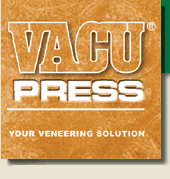Don Stephan

Posts: 825
Joined: 2003-07-18
Location: Cincinnati, Ohio
 User Profile User Profile |
Because I'm just lucky, I guess, I decided to iron on some bookmatched olive ash burl panels (rather than vacuum press them) onto a couple plywood sculpture stands. Taped the panels on the show face using solid 3/4" veneer tape. Dampened the show face (since the wet glue will buckle the veneer), then rolled PVA on the glue side and the substrate. Let both dry for about 2 hours, since some of the glue puddled and was slower to dry. Poured some distilled water into the iron since I read somewhere that steam can help the veneer flatten out.
Dampened the show face, since the glue made the veneer buckle somewhat, and then ironed on the first two panels, beginning with the seam. Getting late in the day, so I rolled PVA on the next two panels and substrates and goosed the infrared heater. As soon as the PVA was dry to the touch (about 90 minutes) dampened the show face and ironed them on. The steam was a-flowing. First panel went on quickly. On the second panel, almost all of the veneer tape rolled right off the seam because of the moisture in the veneer and the heat of the iron. Quick as a flash, that seam started opening up.
Came in the next morning and the third seam had a small gap for about 10 of its 30". Looked at the fourth seam and my life passed before me - could have driven a small runabout up that gap.
On the next four panels, after taping the show face with solid 3/4" veneer tape I ran a strip of 3 hole 3/4" veneer tape on the seam on the glue face. Let the glue, veneer and substrate dry for 4-5 hours. When ironing, I did NOT dampen the veneer, but slowly and gently lowered the iron onto the middle of the seam, allowing the heat time to make the veneer flexible enough to lie flat on the substrate. Heated the seam area only long enough for the glue to become activated. The seams stayed tight for the most part, with minimal gap formation.
By the time I was done with repairs (about 10 hours of practice), I was somewhat proficient at touching up epoxy putty with shellac and fresco powders.
Today I stuck a couple bookmatched walnut burl panels on the tops, using the latter approach, and the seams did not show any gaps.
If you want to try ironing on veneer using PVA, might be worth re-stocking fresco powders first. And BE SURE to have on hand shellac and shellac retarder. A straight 1# cut of shellac dries about as fast as you can dip the brush into the touchup powder.
|





